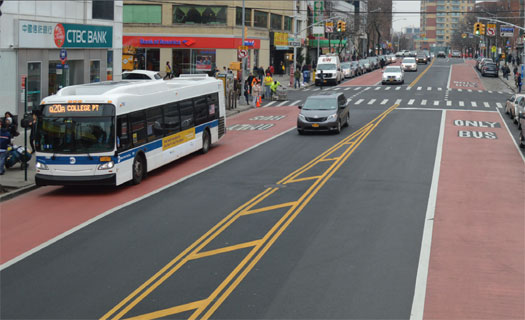The Top 10 Bus Corridors Where DOT Should Make Streets Work For Transit

New York City bus service is the slowest in the nation and riders are abandoning the bus in droves, even as the city’s population steadily increases. To win people back over to the bus, the advocates at the Bus Turnaround Coalition have pinpointed 10 high-priority bus corridors where DOT should make service faster and more reliable.
DOT doesn’t run buses (the MTA does), but it controls the streets. The agency has a powerful toolkit to prioritize surface transit, including dedicated bus lanes, “queue jumps” that give buses a head start at busy intersections, traffic signals that hold green lights for buses, and sidewalk extensions that enable bus drivers to pick up passengers without pulling in and out of traffic.
The ten corridors identified by the Bus Turnaround Coalition have high ridership — together they carry 250,000 weekday passengers, or about 10 percent of all bus riders in the city. They’re also the routes that get slowed down the most during rush hour, when more people need to use them.
The B41, for example, which connects Downtown Brooklyn to Marine Park via Flatbush Avenue, has seen a 20 percent decline in ridership since 2010. There the coalition recommends targeted improvements around Cadman Plaza and south of Prospect Park on Flatbush Avenue.
On the Q58, a major route in central Queens with a daily ridership of almost 30,000, the coalition says the city could improve bus speeds at bottlenecks in Corona and Elmhurst with queue jumps.

The coalition also singles out the Bx19, Bx9, and Bx28 and Bx38 (especially on Gunhill Road); the M57 and M31 on 57th Street and the M101; the B35; the S48 and S98 on Victory Boulevard and Forest Avenue; and three lines that run along 21st Street in Long Island City.
Last summer the coalition released recommendations for the MTA and DOT to improve bus speeds and reliability citywide. So far, MTA officials have not been receptive to the campaign, while NYC DOT has shown more interest.
DOT’s “Mobility Report,” released in June, used BusTime data to pinpoint street segments across the city where buses are slowest, and DOT Deputy Commissioner for Transportation Management & Planning Ryan Russo told Streetsblog the agency had to “lean in even further” on the Select Bus Service program.
The MTA declined to respond to AM New York’s request for comment on the Bus Turnaround Coalition’s list of high-priority routes, deferring to DOT. A DOT spokesperson said the agency will work “with… the MTA and with local communities to improve bus service citywide,” including “bringing SBS-like treatments such as all-door boarding to all bus lines.”





